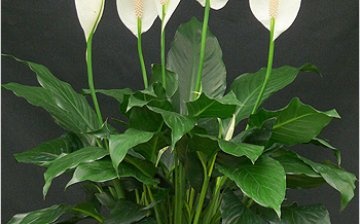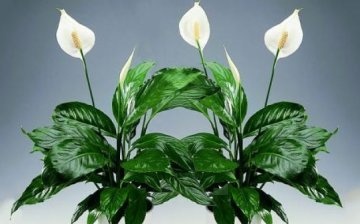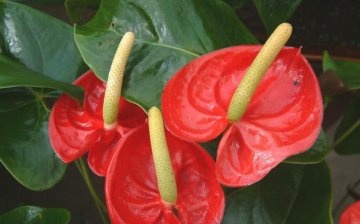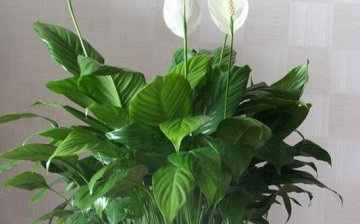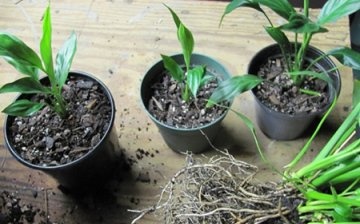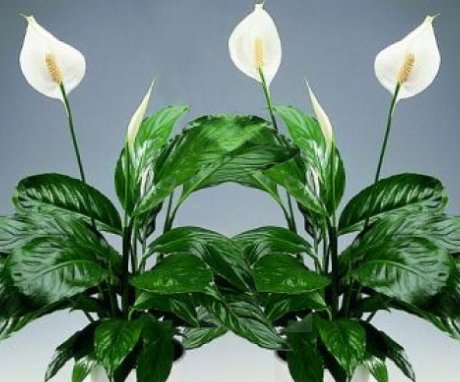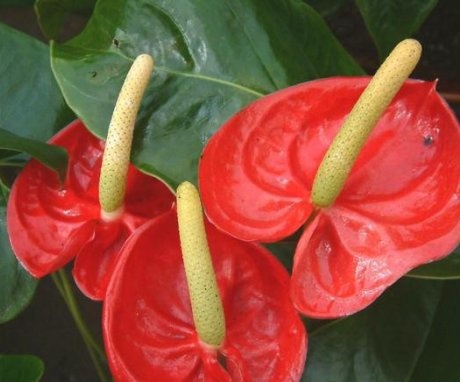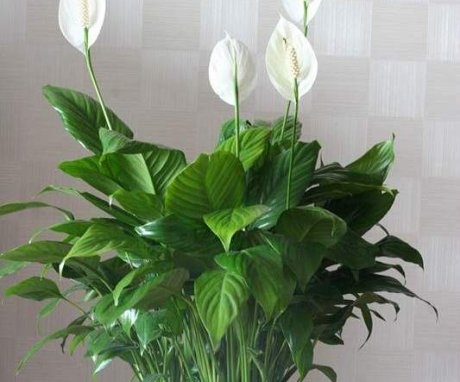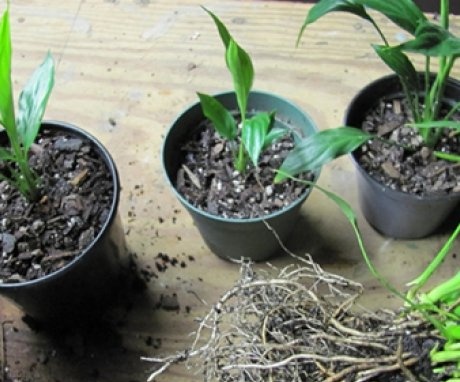Spathiphyllum: description and agricultural technology of the plant
Spathiphyllum belongs to the Aroid family. It is a perennial and evergreen plant that is grown in Europe and Asia as an indoor and ornamental plant.
Content:
Description of spathiphyllum
Let's take a closer look at tropical plant... The size of the bush can vary from 15 cm to 100 cm. The spathiphyllum has no branches, so the leaves grow in a bunch directly from the rhizome. The petioles are long, the leaves are oval in shape and vary in length in different species.
Due to the veins, the leaves are embossed over the entire surface and often wavy along the edges. This plant blooms unusually. The inflorescence is shaped like an ear, which is usually colored white, yellow or green. Near the inflorescence is a veil-petal, oval-oblong in shape with a pointed end. It is painted white or green. The flowering period of spathiphyllum is long and lasts 3-5 weeks.
Types of spathiphyllum
What are the types of plants:
- Wallis Spathiphyllum is unpretentious and grows well in partial shade. Leaves are oval, oblong, glossy, green, emerald green. The size of the plant does not exceed 40 cm; dwarf varieties of this species are also found. It blooms profusely, the inflorescence is located on a long peduncle, the petal-veil is narrow, painted in a white tone.
- Spathiphyllum is adorable. This species differs from the others in both leaves and inflorescence. Grows into a fairly large bush. On long petioles, oval, oblong leaves are located, their length is much longer than that of other similar species. They are painted dark green, glossy ribbed. The inflorescence is also longer than that of other spathiphyllums, located on a thick long peduncle. The petal bedspread has a greenish tint. It blooms for a long time and profusely, it happens 2 times a year with proper care.
- Abundantly flowering spathiphyllum belongs to low plants, its maximum height is 60 cm. Leaves are oval, lacent, have a velvety surface and are colored green, which brightens towards the middle. On the underside, the leaves are lighter and more opaque. Blooms heavily for 3-4 weeks.
- Spathiphyllum is spoon-shaped. Its leaves can reach a height of 100 cm. Their shape is oval, oblong. The leaf can be up to 40 cm long and 20 cm wide, located on an oblong petiole. The leaves are painted green, the surface is glossy, dark, the edges are wavy. The inflorescence is located on a long peduncle with an oval petal.
- Spathiphyllum cannoli. Leaves of this species resemble cannes leaves and are ovoid. Their size is large, the color is emerald green, the surface is glossy. It is quite rare. It blooms for a long time.
- Spathiphyllum is a heliconiiferous houseplant in height can reach 1 meter. Leaves are oblong, oval at the ends, pointed, glossy. Leaf length up to 50 cm, width up to 25 cm, painted green, wavy at the edges. At the end of a tall peduncle there is a large petal with a short thick core, which is colored white, like the petal. Over time, the core darkens. The homeland of this type of spathiphyllum is Brazil.
- Spathiphyllum Mauna Loa is the most popular species, its height can reach 70–80 cm. Leaves are broadly oval and dark green in color. Over time, the old leaves droop, but do not dry out, but remain green, and due to this, with age, the bush acquires splendor. The flower consists of a large oval-shaped petal, which is painted in white, and a convex, oblong, milky core. Mauna Loa spathiphyllum flowers are often used cut for bouquets.
- Spathiphyllum Domino is considered one of the most beautiful and decorative types of spathiphyllum. The small plant has a beautiful variegated leaf color, which distinguishes it from its counterparts. Medium-sized inflorescence with high peduncle. The large petal is white, the core, which looks like an ear, has a yellowish tint, which turns green over time.
- Spathiphyllum Picasso belongs to the young, recently bred varieties. The leaves of this potted plant are large, similar in shape to other species, but the color is different. One Spathiphyllum Picasso may have leaves that are dark green, white, or partially green and white. This species prefers to grow in good light or partial shade.
- Spathiphyllum Caiti grows up to 70 cm. The leaves are large, soft to the touch, colored green with yellow blurred blotches. The advantage of this type is that it perfectly tolerates excess moisture. Therefore, it can be planted near decorative ponds.
- Spathiphyllum Sensation is a Dutch variety of this plant. This giant among pets can reach a height of 1.5 meters. The leaves are large, located on high petioles. The shape is oblong, oval. In length, they can be up to 90 cm in width up to 40 cm. The leaves are colored green, pointed at the ends and have ribs along the entire surface of the plate. There are also large inflorescences on high peduncles.
Plant care
Since spathiphyllum is a rainforest plant at home, it needs special care. The first thing to consider is lighting. The plant does not like to be in the open sun, as burns may appear on the leaves. But even in the shade, the flower will not develop normally. Spathiphyllum requires good lighting, partial shade is possible. With this arrangement of the flower, good development and abundant and regular flowering are guaranteed.
All types of spathiphyllum are demanding on temperature; when it drops to + 10 and below, the plant can rot.
Optimum temperature for spathiphyllum +23 degrees in summer. And in winter +20. Drafts should be avoided, as they can lead to the death of the plant.
Also spathiphyllum is picky about watering:
- In spring and summer, during the flowering period, it should be abundant, but without stagnation.
- The top of the potting soil should dry out between waterings.
- In winter, watering is slightly reduced. But the complete drying out of the earth in the container is unacceptable.
- Before watering, the water is defended for at least 12 hours.
- Air humidity in the room where spathiphyllum grows is directly related to the health of its leaves.
- Since the plant is tropical, the humidity should be increased. To do this, it must be regularly sprayed with soft, settled water from a spray bottle.
- Do not be afraid to overmoisten the plant, excess water flows down the leaf and drips onto the soil. That is why all types of spathiphyllum have pointed and drooping leaf tips.
- In the heating season, air humidification becomes especially important. During this period, spraying should be carried out 2-3 times a day.
In the spring annual plant feeding is required... For this, mineral fertilizers of low concentration are suitable. Before and after fertilization, spathiphyllum must be watered well. The regularity of feeding in the spring is 1 time in 2-3 weeks.
Transplant the plant as needed and in the spring months.
To do this, you need to take a pot a little larger than the old one, put drainage on the bottom. The soil should be slightly acidic and loose so that the water does not stagnate and flows freely down. You can purchase a special primer for aroids. After the plant has been transplanted, it must be moved to a warm place and watered and sprayed regularly.
Reproduction of spathiphyllum
The easiest way to propagate spathiphyllum is to separate the formed daughter plants from the mother bush during transplantation.
A large bush is removed from the pot and neatly divided into several parts. Young shoots should be planted in small pots filled with prepared soil and drainage. The pot should not be very large, as this inhibits the development of the plant. It is best to increase the size of the container for spathiphyllum as you grow.
Young spathiphyllum, reproduction of which is carried out with the help of seeds, develops a little more slowly. However, this method also exists.
It is recommended to sow the seeds immediately after harvesting, as their germination percentage decreases over time.
Another disadvantage of this method is that the variety that was sown may not grow at all. This is especially true for hybrid species and varieties. This ornamental plant is mainly used to decorate home windowsills and winter gardens. Occasionally, it is planted in open ground near water bodies. But such a plant must be moved indoors for the winter, since winter frosts will destroy it.
More information can be found in the video.



